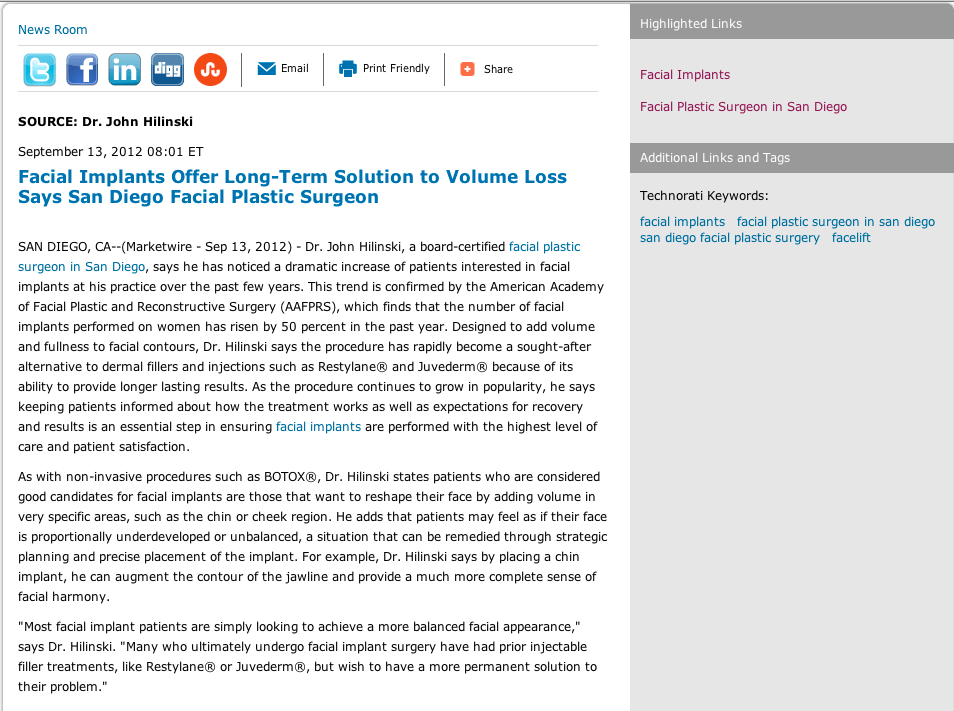San Diego, CA — Dr. John Hilinski, a board-certified facial plastic surgeon in San Diego, says he has noticed a dramatic increase of patients interested in facial implants at his practice over the past few years. This trend is confirmed by the American Academy of Facial Plastic and Reconstructive Surgery (AAFPRS), which finds that the number of facial implants performed on women has risen by 50 percent in the past year. Designed to add volume and fullness to facial contours, Dr. Hilinski says the procedure has rapidly become a sought-after alternative to dermal fillers and injections such as Restylane® and Juvederm® because of its ability to provide longer lasting results. As the procedure continues to grow in popularity, he says keeping patients informed about how the treatment works as well as expectations for recovery and results is an essential step in ensuring facial implants are performed with the highest level of care and patient satisfaction.
As with non-invasive procedures such as BOTOX®, Dr. Hilinski states patients who are considered good candidates for facial implants are those that want to reshape their face by adding volume in very specific areas, such as the chin or cheek region. He adds that patients may feel as if their face is proportionally underdeveloped or unbalanced, a situation that can be remedied through strategic planning and precise placement of the implant. For example, Dr. Hilinski says by placing a chin implant, he can augment the contour of the jawline and provide a much more complete sense of facial harmony.
“Most facial implant patients are simply looking to achieve a more balanced facial appearance,” says Dr. Hilinski. “Many who ultimately undergo facial implant surgery have had prior injectable filler treatments, like Restylane® or Juvederm®, but wish to have a more permanent solution to their problem.”
Although there are a variety of materials that may be used for facial augmentation, Dr. Hilinski prefers a silicone plastic, or silastic, implant at his San Diego facial plastic surgery practice because they offer a much safer and more predictable outcome. Other materials include porex and goretex; however, he says these can often elicit a tissue reaction from the body, which can cause the implant to move or lead to a higher incidence of implant rejection. Dr. Hilinski adds that after years of having used silastic implants, he is much more familiar with the array of sizes and shapes available and how each one can be used to enhance facial appearance.
“Whenever a foreign material is placed into the body, there is always the risk of rejection,” he says. “Fortunately, this risk is minimal when facial implants are placed correctly by board-certified facial plastic surgeons with experience in augmentation of the face with implants. There is also a potential risk of damaging the nerves around the face that provide sensation and/or movement. Again, this risk is quite rare when facial implants are performed by reputable facial plastic surgeons with dedicated experience in this particular area.”
Like other facial rejuvenation procedures such as a facelift or rhinoplasty, Dr. Hilinski says patients should expect to experience a moderate amount of initial swelling during the first few days where the implant is placed, though most begin to see a significant decline by the end of the first week. When performed properly by a board-certified facial plastic surgeon, he says the procedure may still take many more months for the complete healing process to be final, but patients should notice drastic improvement in the fullness and vibrancy of their face almost immediately:
“The huge upside of having a facial implant is the expectation that one should see quite a dramatic enhancement in their facial appearance following placement of a facial implant. And in most cases, facial implants can result in a very natural look as if the patient was born with that particular facial contour.”
About John Hilinski, MD
A graduate of Harvard Medical School, Dr. John Hilinski completed his residency in Head and Neck Surgery at the University of California, San Diego Medical Center, as well as a Facial Plastic and Reconstructive Surgery Fellowship at the University of Illinois, Chicago Medical Center. He is double-board certified in Facial Plastic and Reconstructive Surgery and Head and Neck Surgery, in addition to being a member of the American Academy of Facial Plastic and Reconstructive Surgery, the American Academy of Otolaryngology, and several other professional organizations. Dr. Hilinski currently serves as a Clinical Faculty Instructor at both the University of California, San Diego Medical Center and the Veterans Administration Medical Center.
Located at 3720 Fourth Avenue in San Diego, CA, Dr. Hilinski’s practice can be reached at (619) 296-3223. He and his team can also be contacted online via the websites drhilinski.com or facebook.com/drhilinski.

